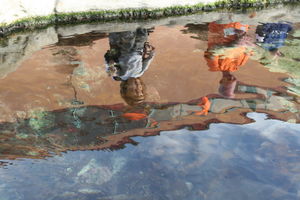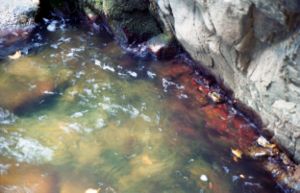Pond
2007 Schools Wikipedia Selection. Related subjects: Recreation

A pond in Peterhof formal garden. In a baroque gareden such as this, it would normally have been called a basin, following French practice.
|
A pond is typically a body of water smaller than a lake. However the difference between a pond and an artificial lake is subjective. They are both formed by ponding water, either by excavating a hollow in which water may lie or by forming a dam to impound the water in a valley. The techniques may be combined to form a reservoir in flat country by enclosing an area with an embankment. Such a pond, unless very small, is usually called a reservoir. In some cultures, the meaning has been extended to include small bodies of water impounded naturally. (Oxford English Dictionary)
Scientifically, a pond is any body of water where light is found in the entire body of water. A lake is any body of water that has a profundal zone; there is as limit of effective light penetration for organisms. Hence, Lake Superior can theoretically be defined as Pond Superior because light does extend to the bottom of the "lake".
Nomenclature
In origin, pond is a variant form of the word pound, meaning a confining enclosure. As straying cattle are enclosed in a pound so water is enclosed in a pond. In earlier times, the uses of ponds were utilitarian; as stew ponds, mill ponds and so on. In medieval and baroque gardens, artificial bodies of water were called ponds or basins. As landowners began to decorate their parks with naturalistic bodies of water, they chose to distance their new, generally larger, decorative ponds from the prosaic and called them lakes. In this seems to lie the origin of the size distinction between lake and pond.
Also, where minerals such as gravel were extracted, the remaining hole might fill with water which, in time came to look natural. In some areas, such as Surrey such pools were called ponds. (An exalple is Frensham Ponds, though even in Wimbledon, which was in Surrey, such pools are meres.) This association of the pond name with a natural-seeming pool seems to have been carried abroad with emigrants so that in places like the United States, natural pools are often called ponds. Much of this article is written on the basis of this American view.
A pond is characterized as being a small body of water that is shallow enough for sunlight to reach the bottom, permitting the growth of rooted plants at its deepest point. Seldom do ponds reach more that 3.6-4.5 meters (12 to 15 feet) in depth.
Pond usually describes small bodies of water, generally smaller than one would require a boat to cross. Another definition is that a pond is a body of water where even its deepest areas are reached by sunlight or where a human can walk across the entire body of water without being submerged. In some dialects of English, pond normally refers to small artificially created bodies of water.
Though not generally accepted, some regions of the United States define a pond as a body of water with a surface area of less than 10 acres (40,000 m²).
Regional differences include the use of the word pond in New England, and Maine in particular, for relatively large waterbodies. For example, Great Pond, Maine, is over 10 square miles in area.
In areas which were covered by glaciers in the past, some ponds were created when the glaciers retreated. These ponds are knowns as kettle ponds . Walden Pond in Concord, Massachusetts is a well known example. Kettle ponds are usually quite deep and clean because they are fed by underground aquifers rather than streams.
Another suggested difference between ponds and lakes is that lakes are fed by rivers, creeks, and/or springs, while ponds are usually the result of rain runoff, modest springs, or perhaps a very small stream. Also, lakes tend to have much more irregular shorelines, with coves and so forth, while ponds tend to allow one to take them all in visually from a single location. Or, if the lake does have regular shorelines, then it tends to at the same time be a substantial body of water (e.g., Lake Okechobee). Lastly, while ponds may allow water to escape via some fairly modest route, lakes that allow such escape usually make use of more substantial means (creeks, rivers, etc.).
Characteristics
Typically, a pond has no surface outflow draining off water and ponds are often spring-fed. Hence, because of the closed environment of ponds, such small bodies of water normally develop self contained eco-systems. Ponds in heavily vegetated areas also display the formation of " scum", which is a common term for dead and decaying vegetation condensing on top of the water. A contributor to this is the presence of algae, which multiply quickly in a nutrient-rich eutrophic pond exposed to strong daylight. Decaying flora provide significant amounts of such nutrients.
In medieval times in Europe, it was typical for many monasteries and castles (small, partly self-sufficient communities) to have fish ponds. These are still common in the East Asia (notably Japan), where koi may be kept.
The term is also used for temporary accumulation of water from runoff (ponded water).
There are various regional names for naturally occurring ponds. In Scotland, one of the terms is lochan.
The word "pond" is sometimes also used to refer to the Atlantic Ocean in the expression "across the pond" (a deliberate idiomatic understatement).

